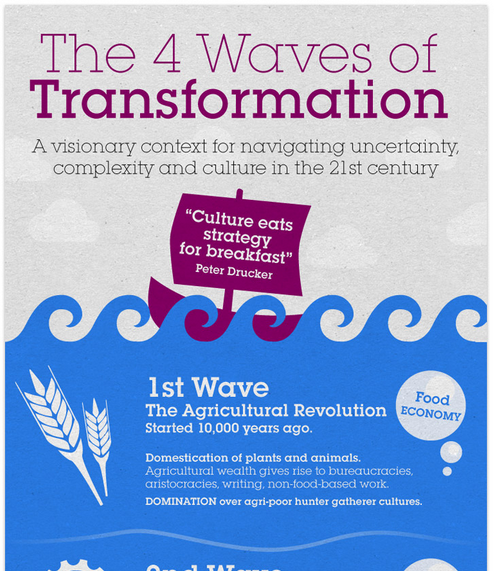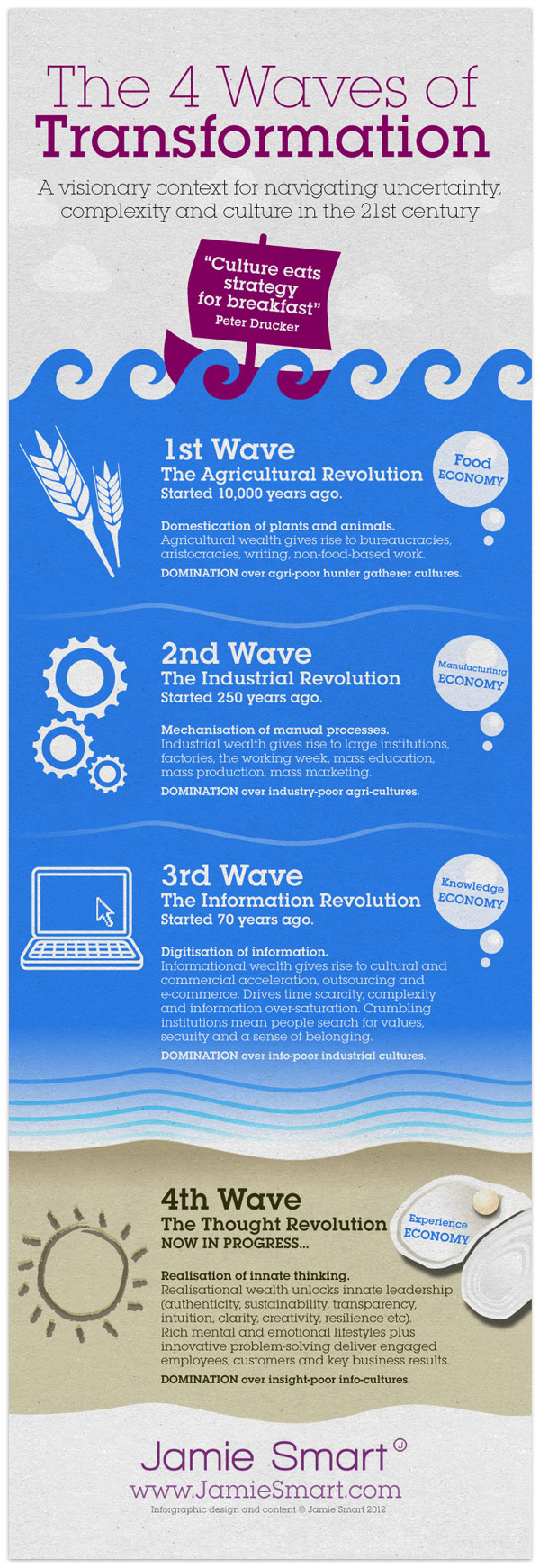Navigating in Times of Uncertainty, Complexity and Chaos – Part 1
“You’ve got to think about big things while you’re doing small things,so that all the small things go in the right direction.”
– Alvin Toffler
The world is changing fast. Increases in speed, complexity and knowledge are accompanied by uncertainty, time-scarcity and information-overwhelm. People shake their heads as they bemoan “the state of the nation” and hark back to simpler times. But what if there’s a larger pattern behind the changes we’re experiencing? In this article, you’re going to discover what that larger pattern is, what it means for businesses and individuals, and what you can do to ride the waves of change, rather than battle against them.
The waves of transformation
In their seminal book “The Third Wave”, Alvin and Heidi Toffler used the metaphor of waves to describe the revolutionary changes that have swept over the globe through history. Each “wave” solves existing problems, while creating new possibilities, new benefits and new challenges. Solutions to the new problems are delivered by the next wave. In brief, here are the 3 waves the Tofflers described:
1st Wave: The Agricultural Revolution
The 1st wave starts around 8000 BC with the domestication of plants and animals, resulting in stabilisation of food supplies. For the first time in human history, some members of the tribe are freed from the daily work of finding food. In the process, new opportunities, problems and solutions arise: writing (to keep track of “agricultural wealth”), bureaucracy (people to do the writing) and aristocracy (to oversee bureaucrats, settle disputes etc). Labourers and managers are needed to get the work done, and urban centres start emerging. Armies protect valuable food-economy territory. Religions take up the slack as people leave the security and connection of the close-knit tribe. Over time, increasing agricultural wealth allows agri-cultures to dominate hunter-gatherer cultures.
2nd Wave: The Industrial Revolution
The 2nd wave starts around 1760 with the mechanisation of manual labour, resulting in the mass production of goods. Once again, new opportunities, problems and solutions arise: compliant, consistent workforces are needed to man the factories. Mandatory schooling prepares children to be good factory-workers; used to a working-week, responsive to timetables, unquestioningly obedient. Large institutions become a mainstay of daily life (schools, companies, government), providing a sense of belonging, security and stability. The mass is born: mass production, mass education, mass marketing, mass transport, mass communication, and the mass devastation of 20th century war. Industrial wealth results in “manufacturing economies” that dominate agricultural societies.
3rd Wave: The Information Revolution
The 3rd wave starts around 1940 with the digitisation of information. Advances in the speed of communication and information technology give rise to cultural and commercial acceleration. Complexity, time-scarcity and information-overload are the inevitable result, and “attention” becomes the most valuable commodity. As outsourcing, ecommerce and remote working increase, the power of large institutions reduces; people start searching elsewhere for values, security and a sense of belonging. The “knowledge economy” rewards informational wealth, and dominates info-poor industrial cultures.
Characteristics and considerations
Before we start exploring the emerging 4th wave, it’s worth considering a few characteristics of the waves of transformation that have shaped the world we live in today…
• Successive waves arrive more and more quickly: The gap between waves 1 and 2 is 10,000 years; the gap between waves 2 and 3 is 180 years. As we’ll see, the gap between waves 3 and 4 is less than 70 years.
• As previously mentioned, each wave solves existing problems, while creating new possibilities, benefits and challenges. For instance… The 2nd wave crashes into the 1st wave, resulting in factory farms and industrial food production. The 3rd wave crashes into the 2nd wave, resulting in just-in-time manufacturing and print-on-demand books, and so on.
• As each wave emerges, the culture embraces new stories about its future; new images of itself (remember those 1950s newsreels predicting the robot-enabled, leisure-age of the future?) As the previous wave’s future-images start to fade and disintegrate, positive new stories are needed that align with the new wave and nourish the culture with hope for what it promises.
• There are early indicators (and early adopters) as each wave emerges. For instance, computers used to be the domain of scientists, the military and big business. As the 3rd wave gathered power, “computer geeks”, hobbyists and other early-adopters got involved. The past 30 years have seen computers move from the specialist fringe to the consumer mainstream as they’ve become integrated into our daily living.
• With waves come opportunity. China is currently on a twin-track, developing quickly in both a 2nd wave manufacturing economy and a 3rd wave knowledge economy, graduating huge numbers of engineers. India has a massive IT industry, employing nearly 3 million professionals.
• With each wave comes a reduction in tangibility and an increase in leverage. Specific crops require a certain soil and climate, and have constraints on their yield. Factories are less constrained and can produce more. Knowledge is virtually unconstrained and can be leveraged infinitely.
The author JK Rowling is a great example of this last point. While travelling on a train in 1990, she had the thought of a boy wizard attending wizarding school, and the Harry Potter brand was born. Her idea became a book series, a film series and a range of merchandise. Recently, Warner Brothers launched the Harry Potter studio experience in London (a business generating over £100,000 per day in ticket sales alone). The Harry Potter industry has delighted millions of people and generated billions of dollars. And it all came from a single thought.
And here’s the thing: each successive wave is like accelerant for the wave before it:
• The industrial revolution transformed agriculture
• The information revolution transformed industry
We’re now in the midst of the information revolution – more people than ever before earn their living participating in knowledge work.
So what’s going to be transforming the knowledge economy?
In part two of this article, we’ll be exploring the 4th wave: the Thought Revolution.

